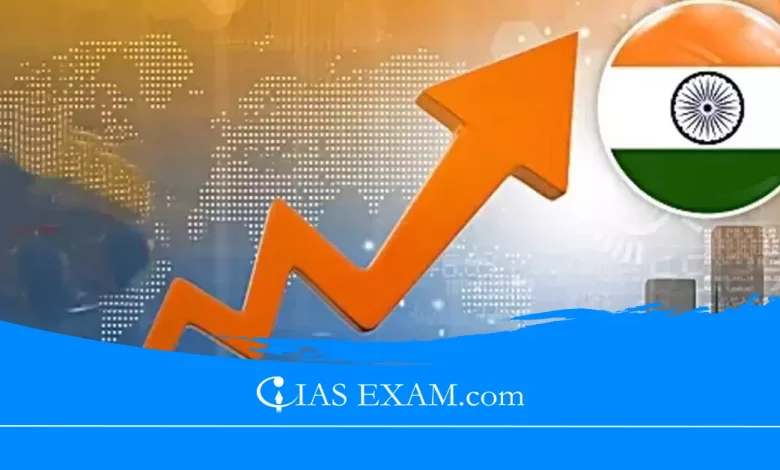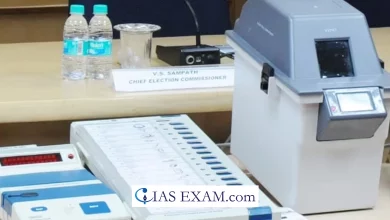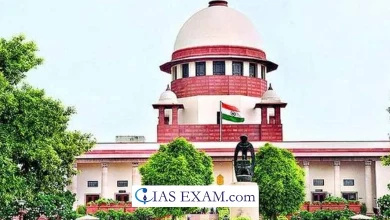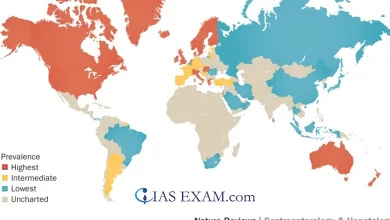Daily Current Affairs for UPSC
FinMin Forecasts 8% GDP Growth This Fiscal Year
Syllabus: Indian Economy, [GS Paper - 3]

Conext
- The Finance Department is positive about the sliding growth rate beyond the 8% which is the NSO estimate that generally implies continued economic growth in the future, and higher analyst reports as well. Notwithstanding the high retail inflation within the target region of 2%-6%, core inflation has been showing indications of recovery.
- Developing Farmers have reported that the ministry has predicted that food prices will go down because of the widespread summer crop sowing. Investment demand is high in the private sector, where the final consumption mainly shows in the expenditures on services in the urban areas, as reported by the air passenger traffic and vehicle sales indicators. Hence an ultimate prediction by FinMin for a Forecasted 8% GDP growth this fiscal year.
Gross Domestic Product
- Gross domestic product (GDP) is an indicator of national economic activity which calculates the total monetary value of all final goods and services produced in the monitored territory during the reported period.
- It is evaluated, employing several assessment approaches, for instance, production assessment, income assessment, and expenditure assessment.
- GDP is considered as a key indicator for the economical health of a country, sometimes used for cross-the-border comparisons and circulations, while also tracking progress.
- Disregarding its crucially important role, GDP still forgets to take account of issues like inequality of payment and environmental sustainability.
- GDP – Gross Domestic Product- is an inclusive indicator of the health of the economy of the country. It is a representation of the total dollar market value of the goods and services (military expenditures excepted) produced within the borders of the country during a particular time period.
- GDP is a sum of private consumption (PFCE), government expenditure (GFCE), contributions coming from gross investment (Gross Fixed Capital Expenditure), plus export/import – subtraction (NX). Such variables exploit the big influence on the suggested GDP and the sectoral output of the country. “Private consumption” can be defined as money which the individuals spend on the different products and services, and “the government spending” occurs when the government provides financial assistance to public services and infrastructure.
- Net investment refers to the entire value of fixed capital assets put into production including machinery and equipment among the major instruments of production in the country.
- Net exports on another hand seem to imply a contrast between exports and imports recorded by a country, which indicates a trade surplus or deficit being experienced by that country with other nations. Integrating these methods, they create a holistic model for the economic activities of each nation and serve as important tools for the officials to make an educated decision on the growth and development.
- The formula used to calculate NDP is the sum of consumer expenditure on goods and services (PCS), gross investment (GI), public consumption to form the national wealth (GCE) and the excess exports over imports if any.
Fiscal Year
- A fiscal year is a period of 12 months where all financial aspects, budgeting, and analysis are done for business and the non-governmental organisations as well.
- Organisations or victims that operate according to the fiscal year may as well be flexible by not necessarily having to take things off on the 1st of January since they can opt to start at any point during the year but they only need to stick to the same time period for planning and making financial statements.
Conclusion
- From that time on, the confidence of the Indian Finance Ministry rose for good as it expected that the country’s economy would grow at a way more than the statistics from National Statistical Office and might gain the range from 8%.
- This growth we look positive at the factories improving and economic results look better, this with factors like retail inflation staying within Reserve Bank of India’s target and a strong property rate in urban areas are the reasons for this growth.
Source: The Hindu
UPSC Mains Practice Question
Q.Discuss the implications of the Finance Ministry’s projection that India’s real GDP growth may reach 8% in the current fiscal year. How does this forecast reflect on the country’s economic resilience and recovery efforts, considering the challenges posed by the global pandemic?





.png)



